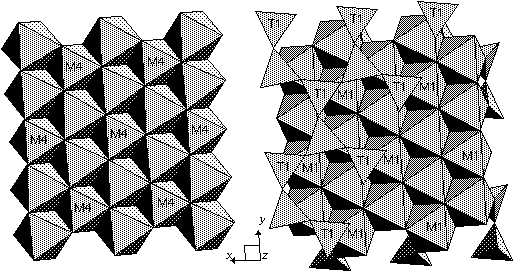
MASH:
The new experimental data of Baker & Holland (1996) pointed to the need for ordering around the clinochlore composition in the magnesium chlorites. The activity model used here is taken from Holland et al. (1997) and relies on the order-disorder models detailed in Holland & Powell (1996b). In magnesium chlorites the octahedral Al is taken as partitioning only into the M4 and M1 sites, with random mixing of Al and Si on two T1 sites. This was the assumption used in HP90, but it is now known that Al orders preferentially onto the M4 site at lower temperatures (Welch et al., 1995).

The parameters of the model are derived from the experimental study of Baker & Holland (1996) and the end-members used in this description are
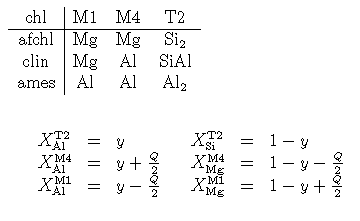
where y is the proportion of ames in the solid solution and the ideal activities are given by:

Therefore y = 0 characterises Al-free chlorite (afchl), y = 1 denotes maximal-Al chlorite (ames), and clinochlore has y = 0.5. The order parameter used is Q = XAl,M4 - XAl,M1. The three end-members are assumed to mix according to a ternary regular solution. The degree of order Q is found by substituting the activities into the equilibrium constant for the internal equilibrium afchl + ames = 2clin. The enthalpy of this reaction is -63 kJ, and the values for Wafchl-ames, Wafchl-clin and Wclin-ames are 20.0, 18.0 and 18.0 kJ/mol respectively. Full details may be found in Holland et al. (1998, Eur J Min, 10, 395). The derived enthalpies of all the chlorite end-members depend on this mixing model.
The calculated activities are given below
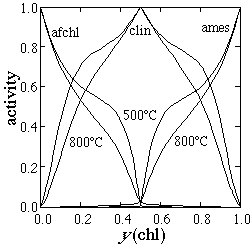
A coded example for THERMOCALC is:
%========= Chlorites in MASH ===============
chl 3
y(chl) 0.51
Q(chl) 0.485
% --------------------------------------------------
p(afchl) 1 1 1 2 -1 y -1 Q
p(clin) 1 1 0 1 2 Q
p(ames) 1 1 0 2 1 y -1 Q
% --------------------------------------------------
sf
W(afch,clin) 18 0 0
W(afchl,ames) 20 0 0
W(clin,ames) 18 0 0
% --------------------------------------------------
6
x(Al,M1) 1 1 0 2 1 y -1 Q
x(Mg,M1) 1 1 1 2 -1 y 1 Q
x(Al,M4) 1 1 0 2 1 y 1 Q
x(Mg,M4) 1 1 1 2 -1 y -1 Q
x(Al,T2) 1 1 0 1 1 y
x(Si,T2) 1 1 1 1 -1 y
% --------------------------------------------------
afchl 1 3 x(Mg,M1) 1 x(Mg,M4) 1 x(Si,T2) 2
check 0 0
clin 4 4 x(Mg,M1) 1 x(Al,M4) 1 x(Al,T2) 1 x(Si,T2) 1
check 1/2 1/2
ames 1 3 x(Al,M1) 1 x(Al,M4) 1 x(Al,T2) 2
check 1 0
and the FASH equivalent is as given
below:
%========= Chlorites in FASH ===============
chl 3
y(chl) 0.51
Q(chl) 0.485
% --------------------------------------------------
p(fafc) 1 1 1 2 -1 y -1 Q
p(daph) 1 1 0 1 2 Q
p(fame) 1 1 0 2 1 y -1 Q
% --------------------------------------------------
sf
W(fafc,daph) 19.3 0 0
W(fafc,fame) 66.8 0 0
W(daph,fame) 16.6 0 0
% --------------------------------------------------
6
x(Al,M1) 1 1 0 2 1 y -1 Q
x(Fe,M1) 1 1 1 2 -1 y 1 Q
x(Al,M4) 1 1 0 2 1 y 1 Q
x(Fe,M4) 1 1 1 2 -1 y -1 Q
x(Al,T2) 1 1 0 1 1 y
x(Si,T2) 1 1 1 1 -1 y
% --------------------------------------------------
fafc 1 3 x(Fe,M1) 1 x(Fe,M4) 1 x(Si,T2) 2
make 3 afchl 1 daph 6/5 clin -6/5
DQF -28.2 0 0
check 0 0
daph 4 4 x(Fe,M1) 1 x(Al,M4) 1 x(Al,T2) 1 x(Si,T2) 1
check 1/2 1/2
fame 1 3 x(Al,M1) 1 x(Al,M4) 1 x(Al,T2) 2
make 3 ames 1 daph 4/5 clin -4/5
DQF -5.2 0 0
check 1 0
%========================================================================
Addition of ferrous iron to the model used here presents the problem of calibrating the required additional energy terms. An independent end-member with which to introduce iron to the system is needed, and a fully Fe-Al ordered end-member, daphnite (daph, Fe5Al[Si3Al]O10(OH)8) is chosen to do this. Ordering of Fe and Mg between sites is not considered, because there is as yet no information on Fe-Mg site partitioning in chlorites. The assumption of equipartition of Fe and Mg between the octahedral sites is used here only as an artefact to reduce the number of parameters needed in the model.
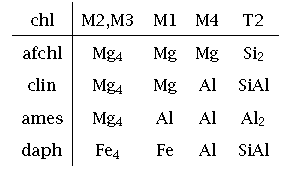
The site distributions may be then written as

The ideal part of the activities is then given by the mixing-on-sites approximation as
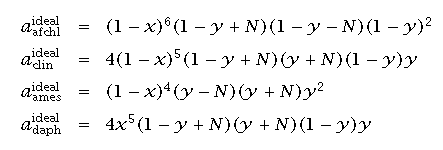
where y is defined as before as X AlT2 and the new compositional variable x is just the proportion Fe/(Fe+Mg) in the chlorite. The non-ideal part of the activity is taken as a regular solution of the four end-members:
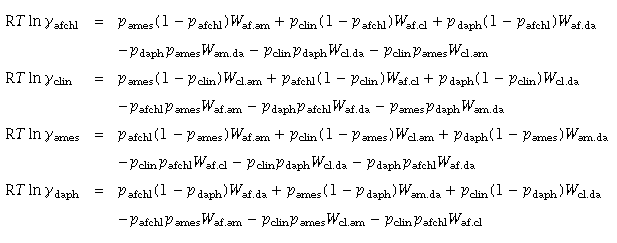
These activity coefficients may be expressed in terms of the independent variables x, y and N (if desired) by noting that the proportions of the four end-members in the fictive quaternary solid solution are pames=y-N, pafchl=1-y-N, pdaph=2x(3-y)/5, and pclin=2N-2x(3-y)/5.
Calibrating the model is difficult, but a number of assumptions, discussed in Holland et al. (1998) have been used to determine a preliminary set of parameters which satisfy some experimental and natural constraints (see diagram below). The proposed interaction energies for FMASH chlorites are (in kJ) Waf.cl = 18, Waf.am = 20, Wcl.am = 18, Wcl.da = 2.5, Waf.da = 14.5, and Wam.da = 13.5. (The last two values have been updated, Oct 98).
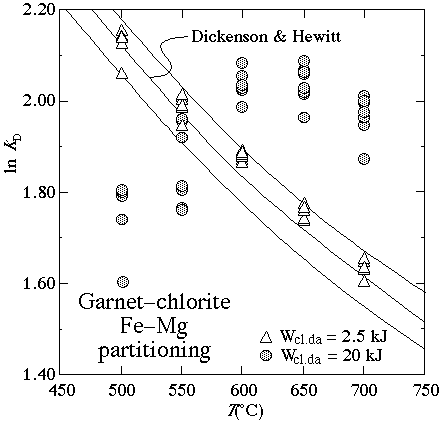
the FMASH THERMOCALC coding is as given below:
%========= Chlorites in FASH ===============
chl 4 % order-disorder model
x(chl) 0.9 % bulk Fe/(Fe+Mg)
y(chl) 0.51 % y = 1/2 = clinochlore-amesite
Q(chl) 0.485 % order parameter
% --------------------------------------------------
p(afchl) 1 1 1 2 -1 y -1 Q
p(clin) 2 1 0 1 2 Q
2 0 1 -2/5 x 3 1 -1 y
p(daph) 1 2 0 1 2/5 x 3 1 -1 y
p(ames) 1 1 0 2 1 y -1 Q
% --------------------------------------------------
sf
W(afch,clin) 18 0 0
W(afchl,daph) 14.5 0 0
W(afchl,ames) 20 0 0
W(clin,daph) 2.5 0 0
W(clin,ames) 18 0 0
W(daph,ames) 13.5 0 0
% --------------------------------------------------
10
x(Fe,M23) 1 1 0 1 1 x
x(Mg,M23) 1 1 1 1 -1 x
x(Al,M1) 1 1 0 2 1 y -1 Q
x(Fe,M1) 1 2 0 1 1 x 1 2 -1 y 1 Q
x(Mg,M1) 1 2 1 1 -1 x 1 2 -1 y 1 Q
x(Al,M4) 1 1 0 2 1 y 1 Q
x(Fe,M4) 1 2 0 1 1 x 1 2 -1 y -1 Q
x(Mg,M4) 1 2 1 1 -1 x 1 2 -1 y -1 Q
x(Al,T2) 1 1 0 1 1 y
x(Si,T2) 1 1 1 1 -1 y
% --------------------------------------------------
afchl 1 4 x(Mg,M23) 4 x(Mg,M1) 1 x(Mg,M4) 1 x(Si,T2) 2
check 0 0 0
clin 4 5 x(Mg,M23) 4 x(Mg,M1) 1 x(Al,M4) 1 x(Al,T2) 1 x(Si,T2) 1
check 0 1/2 1/2
daph 4 5 x(Fe,M23) 4 x(Fe,M1) 1 x(Al,M4) 1 x(Al,T2) 1 x(Si,T2) 1
check 1 1/2 1/2
ames 1 4 x(Mg,M23) 4 x(Al,M1) 1 x(Al,M4) 1 x(Al,T2) 2
check 0 1 0
%========================================================================
|
|